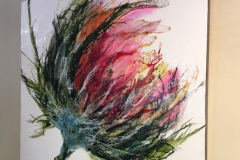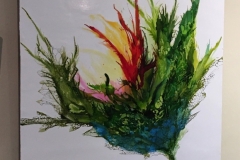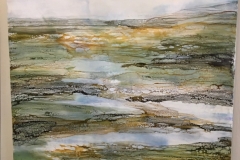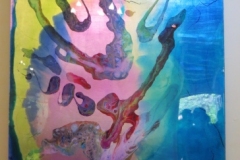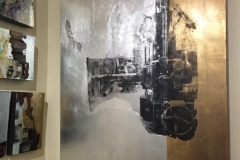
Anderson, Gwen
Gwen Anderson (1961) was born in the Netherlands. Her artist name is Gwenchi, and she holds a master’s degree from the Sir John Cass School of Art in London. Her paintings give the impression of being created by an artist who has spent her entire life in the studio. Yet it was much later in life that Gwen got into art and finished art school.
When Gwen is 13, the Anderson family moves to Curacao. The family consists of Gwen, her parents, and a younger sister, Monique. In 1978, Gwen’s father loses his life in a boating accident. Of the others on board, 17-year-old Gwen, her sister and their two other friends narrowly survive the accident. The tragic event shocks society on the island. Years later, Gwen will reconstruct it on a Dutch television program. Her story is baffling, and it is a miracle that the four children survived. Her father’s body is found a few days later at the water plant; the other three on board remain missing.
In 1980, Gwen completes high school and returns to the Netherlands for further education; she is accepted at the university to study Medicine. Gwen enthusiastically begins her studies but is forced to stop due to disappointing results. It turns out that Gwen has trauma from the accident in 1978. She receives professional counseling but must select another study to keep her scholarship.
Gwen goes on to study Commercial Economics at the HEAO. After that, Gwen completes a course at NEVI to become a buyer. In 1988, she works at the PTT, the predecessor of KPN, as a purchaser of modems. Her sculpture “The Sacred Telephone” (2019) is based on this period and is displayed at the Cathedral of Thorns in Curaçao.
Meanwhile, Gwen meets her husband, Alex, which changes her life. Alex’s work takes the young couple to Amsterdam, New York, London and Japan. During their first stay in New York, Gwen decides to study with the Art Students League of New York. For admission, she must put together a portfolio. She then apprentices with mixed media artist Grace Knowlton (1932-2020).
Gwen spends several years at this school, learning tirelessly and improving her techniques. Art was an outlet for her at that moment, something she enjoyed doing. Gwen still needs to see herself as an artist.
In New York, Gwen gets her certification as a real estate agent, and between jobs, she finds a lovely apartment in the coveted Chelsea neighborhood, where she moves in with Alex. It is a fine, spacious home, but the walls are empty, and it seems to Gwen that she must fill them with beautiful works of art.
Enterprising as she is, Gwen decides that it would be best for her to make her own paintings to fill the walls of their new apartment. She returns to the Art Students League of New York, and this time, her principal teacher is Bruce Dorfman (b. 1936). Under his guidance, Gwen creates 48 large paintings in two years. By the end of their stay in New York, the Chelsea apartment’s walls are filled with Gwen’s paintings.
Then Gwen and Alex move to London, and she continues taking lessons here. During the first year, she takes courses at a studio for photography, ceramics and painting. She meets many young people there and experiences it as an inspiring environment. After that year, Gwen attends the Sir John Cass School of Art, now the School of Art, Architecture and Design, where she may enter the 2nd year.
At this school, Gwen is guided by the influential artist Patrick Brill (b. 1963), who works under the pseudonym Bob and Roberta Smith. This versatile British artist is described as a contemporary artist, writer, musician and activist. Patrick Brill has no interest in Gwen’s large paintings or her lavish use of gold leaf. He brings her back to the narrative, the meaning of art, and the artist’s critical stance.
Under this inspirational guidance from Patrick Brill, Gwen continues to develop. She delves more and more into the intangible elements of life. The importance of color fades into the background. Concept and composition become more important, and she starts a quest to, as she puts it, make the invisible visible.
Gwen is 54 when she completes her masters in 2015 and receives her diploma. It gives her so much satisfaction, not only because years earlier, as a young student, she had to abandon her studies in Medicine unexpectedly. Training at the academy in London is tough. In addition to mastering techniques well, she had to express herself in writing, for example. But the sense of accomplishment is mainly because art has brought her so much, and when she was young, she could never have imagined that this would become her profession.
Art, Gwen says, is a metaphor for life. A painting with bright colors is like a loud conversation. Again, a work in muted, natural colors feels like a quiet conversation. You encounter this contradiction everywhere in life: politics, work, meals, and everything. Life teaches you to balance between those two extremes.
Gwen’s style is lyrically abstract, and an essential aspect of her technique is that she works in layers. Each painting is composed of ever new layers. She also finds that the layering process gives her work a unique dimension, as if it makes it alive. Gwen theorizes that our lives are built in layers because each experience is new. Our memory stores all the layers that determine how we see new experiences. In this context, Gwen refers to the tabula rasa, the idea that human beings are born as unwritten pages and are shaped by experience and perception.
Gwen has lived permanently in Curaçao since 2019 and regularly participates in group exhibitions. She admires many local artists like Ellen Spijkstra, Philippe Zanolino, and Angel de la Rosa. There are many good artists in Curaçao, and there is room for everyone, no matter their level. That also makes the art sector exciting and powerful. She urges her fellow artists to stay with themselves but be open to new ideas.
During the 2020 pandemic, Gwen is the initiator and one of the driving forces behind organizing the Aid 4 Art online art auction. At a time when the world is on lockdown, artists must explore alternatives to still reach the market and be findable. Gwen manages to get the entire art sector behind the project but is inconspicuous in the background herself.
Gwen sees the artists who struggle daily with their work, money and obligations. She finds it unfortunate that Curaçao has no organization to which artists can turn. The problems artists face are often particular and not comparable to other professions. Gwen would like to see a collective or organization where artists in need can turn. Because, Gwen says emphatically, the pandemic is over now, but the need for such an organization is still there.
Written by Josée Thissen-Rojer (2023).
The above text may be reproduced only with mention of the source and author: Curaçao Art®️ www.curacao-art.com. Image rights of the artworks remain the property of the artist.
Click this link for her first solo exhibition in Curaçao, ‘In the Flow’, in 2023.

